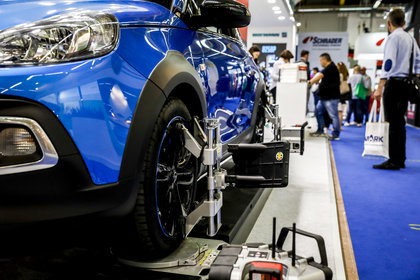
27/07/2017
The race to the future of garage equipment
Massimo Condolo
It seemed almost impossible, but garage equipment is still evolving, with car diagnostics on the front line: more user-friendly hardware and software, the internet as a stable background to retrieve information and updates in almost real time. At the same time, where software is less essential there are talks of quick maintenance service and ergonomics
Diagnostic equipment are still holding the stage. User-friendly interface design, advanced features, and even new generation hardware for an industry where research and development never seems to stop. All credits to new advanced safety systems, which require constant updates, debugging and calibration. Not to mention remote diagnostics, which is certainly not new but is now finally becoming a common practice when it comes to looking for and correcting occasional flaws, and as a logical consequence of the evolution of on-board and infrastructural electronic systems, is now drawing closer to fleet management services for commercial and industrial fleets: nothing strange then, if the next Autopromotec trade show will witness the first integrations of these systems. Something is already on the market, such as systems that match telemetry and the analysis of driving styles and geo-location, albeit with different methods and purposes used in fleet management software. Meanwhile, the many different parameters detected while a vehicle is moving are now joined by thread thickness, crucial when it comes to monitoring the conditions of the tires in a commercial fleet (one of the most troublesome issues fleet managers have to contend with). Speaking about hardware, workshop computers now increasingly resemble our home PCs: high-performance and complex devices are now flanked by simpler and tablet-like devices dedicated to smaller and routing operations. New more powerful and versatile versions of those used by tire fitters up until not long ago to calibrate TPMS sensors, with delicate hard disks replaced by the Solid-State storage devices found also in top-of-the-range laptops. As far as Advanced Driver Assistance Systems (ADAS) such as ACC, lane departure warning and park assist systems, simplicity seems to be the key word, but we are still lacking a universal method shared by component and vehicle manufacturers: for this reason, calibration kits are still rather complex and bulky. Troubleshooting and service databases created by the daily work experience of many specialists are another topical issue: In the past these were made and operated by diagnostic companies through their call centers, nowadays though, it’s the users themselves who are responsible of their creation and management. Nothing short of an Auto-repair Wikipedia. All of this is completed by pass-thru systems that take advantage of dedicated manufacturer’s portals: the in-depth analysis made by the vehicle makers are integrated with information from independent operators. Simpler and faster than ever before, software updates are automatic and work while the devices are connected to the internet without the need for unnecessarily cumbersome procedures speeding up the availability of new information. The network connection is now essential, and no longer reserved to high range diagnostic equipment.
A look at transport fleets
Somewhat apart, we find diagnostic devices for digital tachographs, which in many cases are still followed by workshops responsible for carrying out other activities as well (ranging from official 360° services performed by official networks to other companies specializing in onboard electronics or braking system). The current offer of specialized equipment dedicated to transport fleet internal workshops is also increasingly large: once seemed destined to disappear, but today their speed of action is essential in reducing vehicle downtime. And their offer goes hand in hand with that of a number of official networks as well as component makers, with good prospects for all three. The range of mobile workshops is likewise evolving, with standardized models approved by mainstream service networks, and offered to their partners. The system makes vehicles more efficient and, above all, allows for the best possible control and distribution of costs in a sector where only the entrepreneur's initiative has been the driving factor behind services such as troubleshooting and on-site maintenance assistance. On the agenda we also find battery control and management systems. The recent development of hybrid and electrically driven vehicles, is turning the spotlight on this important component that was never really considered in the past when it came to maintenance operations: we kept it until it stopped working and then replaced it.
More precision and less fatigue
If much of the equipment nowadays is essentially made of a computer that interacts with electronic components that are in turn replaced and not repaired, we cannot neglect machines that perform a purely mechanical work. Here the key words are ergonomics and safety. Auxiliary devices, for example, help lift and position tires on tire changers or balancers, while a control unit monitors all the machine’s working parameters, preventing dangerous imbalances and preventing the machine to start if the wheel is not properly locked. The software itself guides step-by-step the tire fitter during mounting and demounting operations, just as in regulating front and rear setups thus reducing arbitrary decisions and delivering a perfectly safe vehicle to the customer. A special focus on Ergonomics is also applied to small manual equipment, from spanners to screwdrivers, clamps and vises to portable lamps. Handles shaped around the human hand ensuring perfect grip and magnetic systems created to position light sources where needed most (especially looking at the congestion under the bonnet of many vehicles), can now also boast attractive designs, which represents, for Italian and Scandinavian manufacturers alike, a powerful sales & marketing tool.
Vehicle inspections still a key market
Finally, vehicle inspection equipment maintains a strong vitality. Here we are not talking about ground-breaking news as the new rules that are about to come into force have long been known. Rather, the offer now integrates functions dedicated to electric and hybrid vehicles, but above all, the sector is experiencing a new vitality and shows a great growing potential. This is further demonstrated by a tire service network currently offering turnkey equipment and training packages for their associates, after discovering that the national coverage offered by authorized inspection centers is still patch-worked and therefore good business opportunities are there to be seized within the next two years. After that (here comes the warning) the market will be saturated and business opportunities will be available only in case of an inspection center leaving the market which needs to be replaced.
A look at transport fleets
Somewhat apart, we find diagnostic devices for digital tachographs, which in many cases are still followed by workshops responsible for carrying out other activities as well (ranging from official 360° services performed by official networks to other companies specializing in onboard electronics or braking system). The current offer of specialized equipment dedicated to transport fleet internal workshops is also increasingly large: once seemed destined to disappear, but today their speed of action is essential in reducing vehicle downtime. And their offer goes hand in hand with that of a number of official networks as well as component makers, with good prospects for all three. The range of mobile workshops is likewise evolving, with standardized models approved by mainstream service networks, and offered to their partners. The system makes vehicles more efficient and, above all, allows for the best possible control and distribution of costs in a sector where only the entrepreneur's initiative has been the driving factor behind services such as troubleshooting and on-site maintenance assistance. On the agenda we also find battery control and management systems. The recent development of hybrid and electrically driven vehicles, is turning the spotlight on this important component that was never really considered in the past when it came to maintenance operations: we kept it until it stopped working and then replaced it.
More precision and less fatigue
If much of the equipment nowadays is essentially made of a computer that interacts with electronic components that are in turn replaced and not repaired, we cannot neglect machines that perform a purely mechanical work. Here the key words are ergonomics and safety. Auxiliary devices, for example, help lift and position tires on tire changers or balancers, while a control unit monitors all the machine’s working parameters, preventing dangerous imbalances and preventing the machine to start if the wheel is not properly locked. The software itself guides step-by-step the tire fitter during mounting and demounting operations, just as in regulating front and rear setups thus reducing arbitrary decisions and delivering a perfectly safe vehicle to the customer. A special focus on Ergonomics is also applied to small manual equipment, from spanners to screwdrivers, clamps and vises to portable lamps. Handles shaped around the human hand ensuring perfect grip and magnetic systems created to position light sources where needed most (especially looking at the congestion under the bonnet of many vehicles), can now also boast attractive designs, which represents, for Italian and Scandinavian manufacturers alike, a powerful sales & marketing tool.
Vehicle inspections still a key market
Finally, vehicle inspection equipment maintains a strong vitality. Here we are not talking about ground-breaking news as the new rules that are about to come into force have long been known. Rather, the offer now integrates functions dedicated to electric and hybrid vehicles, but above all, the sector is experiencing a new vitality and shows a great growing potential. This is further demonstrated by a tire service network currently offering turnkey equipment and training packages for their associates, after discovering that the national coverage offered by authorized inspection centers is still patch-worked and therefore good business opportunities are there to be seized within the next two years. After that (here comes the warning) the market will be saturated and business opportunities will be available only in case of an inspection center leaving the market which needs to be replaced.








